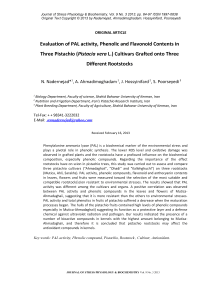Evaluation of pal activity, phenolic and flavonoid contents in three pistachio ( Pistacia vera L.) cultivars grafted onto three different rootstocks
Автор: Nadernejad N., Ahmadimoghadam A., Hossyinifard J., Poorseyedi S.
Журнал: Журнал стресс-физиологии и биохимии @jspb
Статья в выпуске: 3 т.9, 2013 года.
Бесплатный доступ
Phenylalanine ammonia lyase (PAL) is a biochemical marker of the environmental stress and plays a pivotal role in phenolic synthesis. The lower ROS level and oxidative damage was observed in grafted plants and the rootstocks have a profound influence on the biochemical composition, especially phenolic compounds. Regarding the importance of the effect rootstocks have on scion in pistachio trees, this study was carried out to assess and compare three pistachio cultivars ("Ahmadaghaii", "Ohadi" and "Kallehghuchi") on three rootstocks (Mutica, Ahli, Sarakhs). PAL activity, phenolic compounds, flavonoid and anthocyanin contents in leaves, flowers and fruits were measured toward the selection of the most suitable and compatible rootstock/scion resistant to environmental stresses. The results showed that PAL activity was different among the cultivars and organs. A positive correlation was observed between PAL activity and phenolic compounds in the leaves and flowers of Mutica- Ahmadaghaii, suggesting that it is more resistant than the others to environmental stresses. PAL activity and total phenolics in fruits of pistachio suffered a decrease when the maturation processes began. The hulls of the pistachio fruits contained high levels of phenolic compounds especially in Mutica-Ahmadaghaii) suggesting its function as a protective layer and a defense chemical against ultraviolet radiation and pathogen. Our results indicated the presence of a number of bioactive compounds in kernels with the highest amount belonging to Mutica- Ahmadaghaii, and therefore it is concluded that pistachio rootstocks may affect the antioxidant compounds in kernels.
Pal activity, phenolic compound, pistachio, rootstock, cultivar, antioxidant
Короткий адрес: https://sciup.org/14323790
IDR: 14323790
Текст научной статьи Evaluation of pal activity, phenolic and flavonoid contents in three pistachio ( Pistacia vera L.) cultivars grafted onto three different rootstocks
Environmental stresses indicated the most Environmental factors such as temperature, limiting conditions for horticultural productivity. nutrition, light, metal ion concentration, and pathogens influence the growth, development and yield of plants. One way out of these problems is to develop crops that are more tolerant to such stresses. A special method of adapting plants to external stresses is by grafting elite, commercial cultivars onto selected vigorous rootstocks (Lee and Oda, 2003). Different studies on vitis (Koundouras et al. 2008) and pistachio (Gijon et al., 2010) showed that rootstocks had an important influence on the tree water relations, vegetative growth and response to water stress. As rootstock provide a root system to the scion variety grafted onto them, and affect numerous physiological and biochemical changes in the scion leaves (Satisha et al., 2005). Pistachio is one of the most important horticultural crops that is considered a potential crop for many arid and semi-arid region. Selection of suitable genotypes, resistant to unfavorable environmental and soil conditions and diseases, are important for increasing yield efficiency and the acreage of this important crop (Gijon et al., 2010)
Phenylalanine ammonia-lyase, PAL (EC 4.3.1.5) is a sensitive indicator of stress conditions, and it is commonly considered as a biochemical marker indicating the synthesis of both structural and protective compounds. It plays a pivotal role in phenolic synthesis in response to different stimuli (Buchanan et al ., 2000; Boudet, 2007; Vogt, 2010). The activity of this enzyme is one of the key processes in plant cell resistance against various types of stress (Dixon and Paiva, 1995).
Phenolic compounds one of the main secondary metabolites are considerable physiological and morphological importance in plants. It is thought that the molecular basis for the protective action of phenolic compounds in plants is their antioxidant and free radical scavenging properties. Flavonoids and anthocyanins are a ubiquitous group of polyphenolic substances which are present in most plants with a vast array of biological function, including apparent roles in stress protection (Kliebenstein, 2004).
The effect of rootstock on the quality of sweet cherry fruits, have shown that some of the rootstock influenced biologically active compound content such as the polyphenol and anthocyanin content (Spinardi et al ., 2005).
Effects of rootstock and scion on phenylpropanoid pathway metabolites have not been studied yet in pistachio tree. This study was carried out to assess and compare three pistachio cultivars and three rootstock in relation to phenylpropanoid pathway metabolites (PAL activity, phenolic, flavonoid and anthocyanin) for selecting the most suitable and compatible rootstock and scion in order to obtain the highest yield and quality, resistance to environmental stresses.
MATERIALS AND METHODS
Reagents and equipments
Folin-Ciocalteu’s phenol reagent was purchased from Merck KGaA (Darmstadt, Germany). Standared gallic acid, quercetin 3-rutinosid (rutin) were purchased from Sigma Chemical CO. (St. Louis, MO). All chemicals were of analytical grade.
Equipments were used: UV-visible spectrophotometer, Cary 50 conc VARIAN, Australia, Centrifuge Eppendorf 5804R Hamburg Germany
Sample collection and preparation
The experiment was conducted in 2010 at the research station of Iran’s Pistachio Research Institute (IPRI). The 15 year old commercial cultivars, ‘Kallehghuchi’ ‘Ohadi’ and ‘Ahmadaghai’ were grafted on a variety of rootstock cultivars.
Three rootstocks were used including: ( Pistacia atlantica sub sp . Mutica), ( P. vera cv. Badami riz (Ahli) and ( P. vera cv. Sarakhs). Trees were trained with an open-center system and distance of trees were 4×7 m. A split plot experiment in Randomized Complete Block Design with three replications. The three commercial cultivars (scion) were assigned to main plot and the three rootstocks were assigned to subplot within each main plot. The plant materials were collected in April (flower), July (leaf) and pistachio fruits were randomly selected for sampling throughout ripening, from the young to the harvest date, on the following dates: green hull (July), green-red hull (August), red hull (early-September), kernel at harvesting time (late-September). The plant materials were subsequently frozen in liquid nitrogen and stored at -80 °C for the analysis. Before and during the experiments, the trees received standard horticultural care typical of commercial production, including soil type, irrigation, fertilization and pest control
Phenylalanine Ammonia Lyase Activity
Phenylalanine ammonia lyase (PAL) was extracted from fresh cell mass (300 mg fw) with 6.5 ml of 50 mM pH 8.8 Tris-HCl buffer containing 15mM of ß-mercaptoethanol in an ice-cooled mortar, ground with a pestle for about 5 min. The homogenate was centrifuged for 30 min, and the supernatant was collected for enzyme assay. PAL activity was determined based on the rate cinnamic acid production. Briefly, 1 ml of the extraction buffer, 0.5 ml of 10 mM L-phenylalanine, 0.4 ml of deionized water and 0.1 ml of enzyme extract were incubated at 37 °C for 1h. The reaction was terminated by the addition of 0.5 ml of 6 M HCl, and the product was extracted with 15 ml ethyl acetate followed by evaporation to remove the extracting solvent. The solid residue was suspended in 3 ml of 0.05 M NaOH and the cinnamic acid concentration was measured spectrophotometrically by the absorbance at 290 nm. One unit of PAL activity is equal to 1 μmol of cinnamic acid produced per min (Wang et al., 2006). Protein was estimated according to Bradford (1976) using BSA as a standard.
Total phenolic compounds
Total phenolic content was determined using the Folin-Ciocalteau method Singleton and Rossi (1965) as modified by Velioglu et al ., (1998). Samples (100 mg) were extracted with 80% methanol containing 1% hydrochloric (5 ml) at room temperature for 2 hr on a shaker. The mixture was centrifuged at 3000g for 10 min. The supernatant was used for to determine total phenolics. One hundred microliter of extract was mixed with 0.75 ml of Folin- Ciocalteu reagent (previously diluted 10-fold with distilled water) and allowed to stand at 22 °C for 5 min; 0.75 ml of sodium bicarbonate (60 g/L) solution was added to the mixture. After 90 min at 22 °C, absorbance was measured at 725 nm. Gallic acid was used for constructing the standard curve. Results were expressed as mg gallic acid (GA) per gram of the fresh weight.
Total flavonoids
One hundred milligrams of samples were extracted with 10 ml 80% aqueous methanol. The mixture was centrifuged for 10 min at 2000g. Supernatants were used for subsequent analysis. The flavonoid content was measured employing the colorimetric assay described by Zhishen et al., (1999). 0.5 ml aliquots of extracts were added to 10 ml volumetric flask containing 4.5 distilled water. 0.3 ml 5% sodium nitrite was added to each aliquot after 5 min, then 0.6 ml of 10% aluminum chloride was added. After 6 min, 2 ml of 1 M sodium hydroxide was added to the mixture following by the addition of 2.1 ml distilled water. Absorbance was recorded at 510 nm, and flavonoid content was expressed as mg of rutin equivalent per 100 g of fresh weight.
Anthocyanins
Determination of anthocyanin contents was carried out using the method of Wagner (1979). Samples (0.1 g) were soaked in 10 ml acidified methanol [methanol: HCl 99:1 v/v]. The tissues were crushed and kept at 25 C for 24 h in the dark. The extracts were then centrifuged at 4,000 g for 5 min at room temperature. The absorption rate of the supernatant was read by spectrophotometer at 550 nm. To calculate the amount of anthocyanins, the extinction coefficient 33,000 mol-1 cm-1 was used and anthocyanin content were expressed as μ mol g -1 fw.
Statistical analysis
Data of each parameter were subjected to twoway ANOVA. Significant differences between the means of treatments were determined with 95% confidence ( p ≤ 0.05) limit by Duncan multiple range test (DMRT) using SPSS. Data are shown as the means of three replicates. Correlations between the level characters were determined at 95% and 99%.
RESULTS
Flowers and Leaves
The results showed significant differences ( p ≤ 0.05) in PAL activity, total flavonoids, total phenolic compounds contents in leaves and flowers among three rootstock/scion. Total flavonoid contents of the cultivars were not significantly different in the flowers while they were different among their leaves. PAL activity showed a high trend in Mutica-
Ahmadaghaii leaves and flowers compared to the other rootstock/scion and follwed by Ahli-Ohadi, Sarakhs-Ohadi. The highest total phenolic content was observed in flowers and leaves of Mutica-Ahmadaghaii, also the lowest observed in Sarakhs-Ohadi (Figure 1). The highest total flavonoid content was observed in the leaves of Mutica-Ahmadaghaii but no significant difference was observed between the total flavonoid contents of the flowers in three pistachio rootstocks/scions (Figure 2). Correlations were found among the examined parameters. There was a high positive correlation (99%) between PAL activity and total phenolics and flavonoids in the leaves.
Fruits (Hull, Kernel)
The results showed significant differences (p ≤ 0.05) in PAL activity, total flavonoids, total phenolic compounds and anthocyanin contents in hulls (green, green-red and red) and kernels among three rootstocks/scions (Table I A, B, C). Total phenolics and PAL activity of Pistachio fruits from three rootstocks/scions studied were different remarkably. The results showed decrease in PAL activity and total phenolics during the fruit ripening in all rootstock/scion and at all parts of the fruits, the highest rate in each stage was observed in Mutica- Ahmadaghaii. In early stage of fruit ripening, in green hall, total phenolic compounds of all were high and gradually decreased at the end of ripening. Also antocyanin content in stage of fruit ripening gradually increased and in red hull stage, the highest anthocyanin contents were observed in Ahli-Ohadi and lowest in Sarakhs-Ahmadaghaii. Although all cultivars started accumulating anthocyanin at the first stage, they showed a great increase in anthocyanin content in red hull stage, associated with the ripening process, the process being more obvious mainly in Ohadi cultivar on all rootstocks. Observation showed that the outer part of Ohadi cultivar fruits was strongly colored.
Many differences in total flavonoids were observed in all rootstock/scions in fruit ripening stage but generally total flavonoids in fruit ripening decreased and in red hull stage in Mutica-Ahmadaghaii the highest total flavonoids were detected. At the harvest time, kernels showed the lowest rates of PAL activity and total phenolic compounds. In this stage, total phenolic contents and PAL activity of kernel from all three pistachio rootstocks/scions were the lowest than the other stages. The highest PAL activity, total phenolics and total flavonoids obtained in kernel of Mutica-Ahmadaghaii and anthocyanin contents were highest in Ahli-Ohadi cultivar than the others in fruit ripening stage (Table I, D).
Table 1. PAL activity, total phenolic, total flavonoid and antocyanin content in green hull (A), green-red hull (B), red-hull (C) and kernel (D) of pistachio Rootstock/cultivar
A: green hall
|
Rootstock-cultivar |
PAL activity (Unit mg-1 protein) |
Total phenolic (mg GA g-1 fw) |
Total flavonoid (mg Ru 100 g-1fw) |
Antocyanin content (μ mol g-1 fw) |
|
Ahli- Ohadi |
1.82 ± 0.05 b |
36.13 ± 0.28 b |
36.20 ± 0.19 b |
7.66 ± 0.2 a |
|
Ahli - Kallehghochi |
1.56 ± 0.01 c |
29.82 ± 0.21 c |
32.67 ± 0.25 d |
7.35 ± 0.05 a |
|
Ahli- Ahmadaghaii |
1.38 ± 0.03 d |
28.82 ± 0.32 c |
35.68 ± 0.16 b |
6.10 ± 0.07 e |
|
Mutica - Ohadi |
1.86 ± 0.02 b |
28.68 ± 0.31 c |
38.90 ± 0.24 a |
7.05 ± 0.13 bc |
|
Mutica- |
2.15 ± 0.03 a |
29.4 ± 0.61 c |
32.87 ±0.16d |
b 0.1 ± 7.27 |
|
Kallehghochi Mutica |
2.31 ± 0.05 a |
39.12 ± 0.28 a |
30.33 ± 0.24 f |
6.51 ± 0.07 cd |
|
-Ahmadaghaii Sarakhs- Ohadi |
1.50 ± 0.01 dc |
25.20 ± 0.19 d |
33.33 ± 0.19 c |
6.84 ± 0.28 c |
|
Sarakhs- |
1.38 ± 0.03 d |
22.52 ± 0.28 e |
33.81 ± 0.27 c |
6.25 ± 0.06 de |
|
Kallehghochi Sarakhs-Ahmadaghaii |
1.18 ± 0.03 e |
19.18 ± 0.21 f |
31.60 ± 0.26 e |
3.48 ± 0.03 f |
|
B: green-red hull |
||||
|
Rootstock-cultivar |
PAL activity (Unit mg-1 protein) |
Total phenolic (mg GA g-1 fw) |
Total flavonoid (mg Ru 100 g-1fw) |
Antocyanin content (μ mol g-1 fw) |
|
Ahli- Ohadi |
1.58 ± 0.03 b |
24.48 ± 0.25 c |
28.12 ± 0.32 d |
20.24 ± 0.14 a |
|
Ahli - Kallehghochi |
1.45 ± 0.03 c |
24.21 ± 0.23 c |
31.02 ± 0.21c |
18.82 ± 0.25 b |
|
Ahli- Ahmadaghaii |
e 0.01 ± 1.26 |
18.71 ± 0.18 e |
39.41 ± 0.24 a |
17.73 ± 0.18 bc |
|
Mutica - Ohadi |
1.74 ± 0.02 a |
26.86 ± 0.22 b |
30.90 ± 0.14 c |
17.05 ± 0.13 c |
|
Mutica- |
1.43 ± 0.03 c |
24.2 ± 0.31 c |
34.97 ± 0.16 b |
17.75 ± 0.18 bc |
|
Kallehghochi |
||||
|
Mutica |
1.79 ± 0.05 a |
29.32 ± 0.38 a |
28.30 ± 0.14 d |
16.65 ± 0.16 d |
|
-Ahmadaghaii |
||||
|
Sarakhs- Ohadi |
c 0.04 ± 1.41 |
22.86 ± 0.24 d |
21.18 ± 0.21 e |
18.62 ± 0.2 b |
|
Sarakhs- |
1.35 ± 0.03 d |
18.22 ± 0.19 e |
22.81 ± 0.18 e |
15.14 ± 0.21 e |
|
Kallehghochi |
||||
|
Sarakhs- |
1.22 ± 0.02 e |
15.08 ± 0.18 f |
28.10 ± 0.19 d |
15.12 ± 0.18 e |
|
Ahmadaghaii |
||||
|
C: Red hull |
||||
|
Rootstock-cultivar |
PAL activity (Unit mg-1 protein) |
Total phenolic (mg GA g-1 fw) |
Total flavonoid (mg Ru 100 g-1fw) |
Antocyanin content (μ mol g-1 fw) |
|
Ahli- Ohadi |
1.46 ± 0.02 bc |
22.75 ± 0.24 bc |
21.30 ± 0.49 f |
29.65 ± 0.2 a |
|
Ahli - Kallehghochi |
1.34 ± 0.03 d |
20.71 ± 0.11 d |
30.57 ± 0.37 c |
24.85 ± 0.14 d |
|
Ahli- Ahmadaghaii |
1.12 ± 0.01 f |
16.07 ± 0.15 e |
38.28 ± 0.24 b |
19.66 ± 0.19 f |
|
Mutica - Ohadi |
1.52 ± 0.03 b |
24.78 ± 0.17 a |
19.89 ± 0.12 g |
27.87 ± 0.38 b |
|
Mutica- |
1.42 ± 0.05 c |
23.17 ± 0.3 b |
22.50 ± 0.15 e |
22.23 ± 0.14 e |
|
Kallehghochi Mutica |
1.67 ± 0.02 a |
24.64 ± 0.13 a |
52.40 ± 0.51 a |
21.37 ± 0.12 e |
|
-Ahmadaghaii Sarakhs- Ohadi |
1.30 ± 0.03 ed |
19.27 ± 0.22 d |
21.08 ± 0.18 f |
26.50 ± 0.28 cb |
|
Sarakhs- |
1.28 ± 0.09 e |
16.65 ± 0.18 e |
19.18 ± 0.13 g |
19.35 ± 0.21 f |
|
Kallehghochi Sarakhs-Ahmadaghaii |
1.08 ± 0.01 f |
14.02 ± 016 f |
26.12 ± 0.34 d |
19.50 ± 0.22 f |
|
D: kernel |
||||
|
Rootstock-cultivar |
PAL activity (Unit mg-1 |
Total phenolic |
Total flavonoid |
Antocyanin content |
|
protein) |
(mg GA g-1 fw) |
(mg Ru 100 g-1fw) |
(μ mol g-1 fw) |
|
|
Ahli- Ohadi |
0.92 ± 0.02 a |
3.36 ± 0.03 a |
13.72 ± 0.15 c |
7.66 ± 0.16 a |
|
Ahli - Kallehghochi |
0.84 ± 0.01 b |
2.91 ± 0.03 bc |
12.24 ± 0.14 e |
6.50 ± 0.18 c |
|
Ahli- Ahmadaghaii |
0.75 ± 0.01 c |
2.37 ± 0.08 d |
10.23 ± 0.12 g |
5.49 ± 0.11 d |
|
Mutica - Ohadi |
0.91 ± 0.02 a |
3.40 ± 0.01 a |
12.34 ± 0.24 e |
7.34 0.14 b |
|
Mutica- |
0.81 ± 0.01 b |
2.96 ± 0.05 b |
12.98 ± 0.15 d |
5.44 ± 0.07 e |
|
Kallehghochi Mutica |
0.93 ± 0.02 a |
3.44 ± 0.02 a |
15.24 ± 0.27 a |
6.22 ± 0.15 cd |
|
-Ahmadaghaii Sarakhs- Ohadi |
0.83 ± 0.02 b |
2.90 ± 0.03 bc |
15.07 ± 0.25 a |
7.19 ± 0.12 b |
|
Sarakhs- |
0.79 ± 0.01 c |
2.75 ± 0.11 c |
14.5 ± 0.23 b |
5.49 ± 0.11 e |
|
Kallehghochi Sarakhs-Ahmadaghaii |
0.71 ±0.01 c |
2.27 ± 0.08 d |
11.3 ± 0.16 f |
4.41 ± 0.14 f |
Results are mean ± SE (n = 9), different letters in the same column represent significant differences at ( p ≤0.05) according to Duncan test. GA: gallic acid, Ru: rutin, unit: (1PAL unit = 1 μmol cinnamic acid produced per min)
DISCUSSION
Flowers and leaves
It has been showed that rootstocks have a profound affect on the biochemical composition of the leaves, especially in terms of enzymes and phenols (Sobhana et al ., 2000).The production of ROS under stress conditions remaining lower in rootstock-grafted plants than in non-grafted and the higher activity of antioxidant system in rootstock-grafted plants indicated less oxidative damage occurring (He et al ., 2009). Hura et al .
(2007) indicated that determination of PAL enzyme activities should be explained during the stress period to obtain a better understanding of how resistant and sensitive varieties differ in their response. In another experiment, Hura et al . (2008) also reported a correlation between PAL activity and phenolic compounds in leaves of hybrid maize in drought stress and considered the accumulation of phenolic compounds as the indication of activated defense reaction in the drought resistance of that genotype.
Flower
Leaf
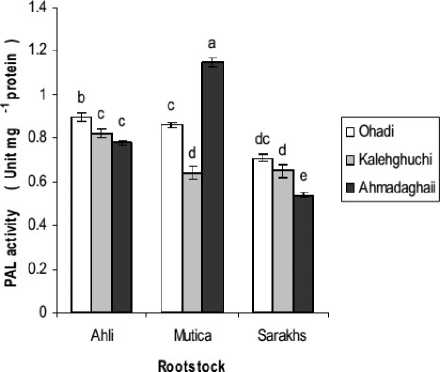
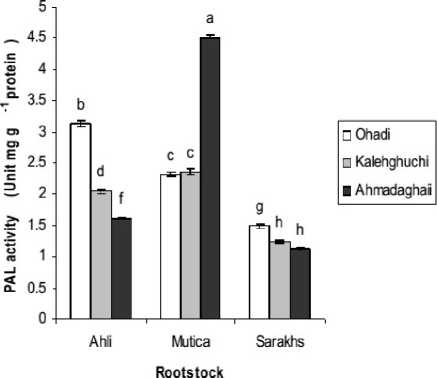
Flower
Leaf
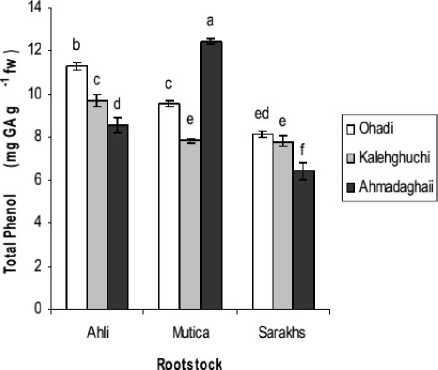
Figure 1. PAL activity and total phenolic in flowers and leaves of three pistachio rootstock/cultivars. Values are the means of 9 replicates (n=9). Means with different letters are significantly different with 95% confidence.
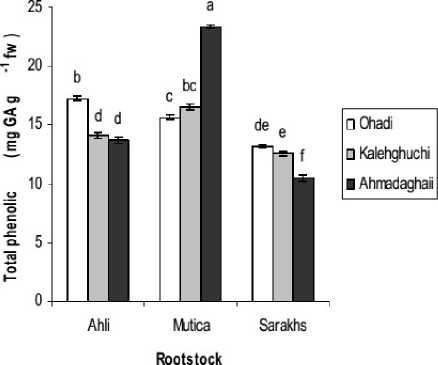
In our study, positive correlation was observed between the increase of PAL activity and total phenolics in leave and flowers in three rootstocks/scions. Increase in PAL activity and the accumulation of high levels of phenolic compounds in Mutica-Ahmadagaii in this study can suggest that this rootstock is more resistant to the stresses than the others and it seem apparently rootstock mutica induced a stress resistance response in Ahmadaghii cultivar with a higher PAL activity and total phenolic than the other two rootstocks. Our results also confirm the positive role of phenolic compounds in plant protection again stress condition. Petkovsek et al. (2009) show total phenolic content of leaves can be a good tool for distinguishing resistant and total phenolics are higher in resistant than susceptible apple varieties. In this study seems the better resistance of pistachio rootstock can be characterized by increase in PAL activity and phenolic level that act as the antioxidants of reactive oxygen species generated under stress influence.
Flower
Leaf
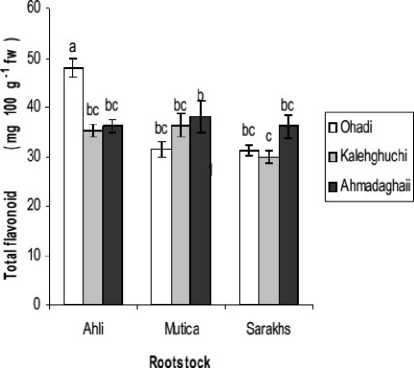
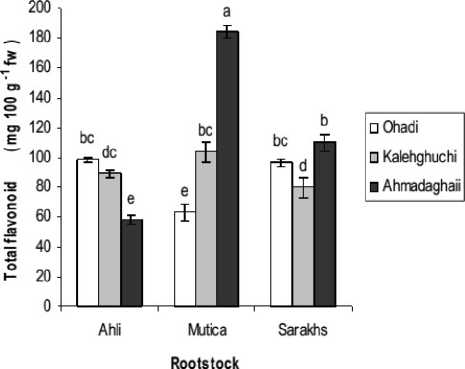
Figure 2. Total flavonoid in flowers and leaves of three pistachio rootstock/ cultivars. Values are the means of 9 replicates (n=9). Means with different letters are significantly different with 95% confidence.
Positive correlation between PAL activity and total flavonoids in rootstocks and cultivars in this study shows that increase in PAL activity possibly induces the production of flavonoids. In agreement with the present results, Cheng et al . (2005) showed that the activity of PAL has a direct effect on flavonoid formation and that the long wave light increased the activity of PAL and CH S1 (the fist enzyme in the flavonoid’s biosynthesis) and also enhanced flavonoids accumulation. According to the literature, mutant plants (deficient in CHS) are unable to accumulate flavonoids and were found to be more sensitive to oxidative stresses (Filkowski et al ., 2004; Shao et al., 2007). It is hypothesized that antioxidant flavonoids have protective function during many stresses and seems that flavonoids accumulation in the leaves and flowers of Mutica-
Ahmadaghaii could be, more than the others, useful for its resistant to the environmental stresses. Evrenosoglu et al ., (2010) considered that one of the reasons for the affirmative changes in plant growth and yield, and disease resistance of Cucurbitaceae rootstocks can be related to the high levels of kaempferol (one of flavonoid), and Petkovsek et al., (2009) indicated the leaves of resistant cultivar contained more flavonoid than those of susceptible cultivars, these coincide with our results that indicated rootstock Mutica can induced formation flavonoids in leaves and flowers Ahmadaghaii cultivar than the others, to function as ROS scavengers, as they may inhibit the generation and reducing ROS (Agati et al ., 2007).
Fruits
Regarding to results observed in the study, we have to conclude that the ripening characteristics of the fruits in three rootstocks/scions affect both on PAL activity and total phenolic contents of pistachio fruits. Both suffered a decrease when the maturation process began during pistachio development. The decrease comparative changes in PAL activity and total phenolics of three rootstock show a correlation between the compounds where highest value observed in rootstock Mutica-Ahmadaghaii. Our results indicated that PAL activity, which is highly sensitive to environmental condition, play a major role in controlling the flux into total phenolics. These data agreed with those of Montero et al. (1996), who observed that PAL enzyme is involved in biosynthesis of phenolic compounds, which are known to accumulate during early stage of development. During organ growth the phenolic profiles often undergo remarkable changes indicating that their metabolism is integrated into programs of growth and development and the decrease of phenolic content in fruits can be attributed to a series of chemical and enzymatic alterations of some of the phenols during ripening (Robards et al., 1999; Ding et al., 2001). The results of this study showed that the phenolic compound content in pistachio fruits differed significantly depending on the rootstock and these results suggest the influence of genetic origin of rootstocks on the phenolic compound content that our results coincide with results of Jakobek et al. (2009) on sweet cherry.
Our results indicated that PAL activity and total phenolic compounds present in outer layer of pistachio fruits that highest value was observed in Mutica-Ahmadaghaii. High concentration of phenolic compounds in fruits often go parallel with low incident by pathogen (Arcas et al., 2000). The lower aflatoxin content of pistachio kernels with hulls compared with hulled kernels is also probably the result of the aflatoxin inhibitory effect of the hulls (Dostr and Michailides 1995). There is also evidence that flavonoids, in some plant organs is restricted to epidermal cells, may function in plants to screen harmful radiation(Reyes-Carmona et al., 2005). Goli et al. (2005) also in agreement to our results showed that pistachio hull is a natural source of phenolic compounds and Tomaino et al., (2010) indicated that these compounds are present higher in skin than in seed. In this study, the outermost layer of the pistachio fruits, nut kernels and the hulls were showed to contain high level of total flavonoid and phenolic compounds. It seems the hulls of pistachio fruits (especially Mutica-Ahmadaghaii) being exposed to the environment may function as a protective layer, thus phenolic compounds tend to accumulation in dermal tissue of plant bodies because of their potential roles of protection against ultraviolet radiation and as defense chemical against pathogens and predators.
Anthocyanin contents in early stages of pistachio fruits development are low and increase during the progress of ripening. In agree with our study Mozetic et al . (2004) reported the single phenolics content decreased during ripening while the anthocyanin content showed linear increase. The highest anthocyanin contents observed in Ahli-Ohadi in the hulls of mature fruits. It seems anthocyanin contents increase in the hulls of mature fruits depend on the variety and the stage of maturity. These findings are consistent with previous studies (Cordenunsi et al ., 2002). It was observed that the outer part of Ahli-Ohadi fruits is strongly colored. Although all rootstocks/scions have started accumulating anthocyanin at the first stage, mainly in Ahli-Ohadi, they showed a great increase in anthocyanin content in red hull stage that associated with the ripening process.
There is no study about the PAL activity in kernel pistachio in the literature. The present results indicate that PAL activity and total phenolics in kernels of pistachio decrease significantly during fruit ripening in harvest time and significant difference between pistachio cultivars exist mainly in Mutica-Ahmadaghaii coinciding with higher value on PAL activity. These findings suggested that PAL may be involved in growth and development during seed maturation, also in the final concentration of phenolic compounds and flavonoids and anthocyanins in the kernels. Ballistreri et al ., (2009) reported pistachio kernels contain a remarkable amount of phenolic compounds such anthocyanins and flavonoids. Silva et al ., (2008) determined high correlation between polyphenolic content and the antioxidant activity. The antioxidant activity of pistachio seed was reported by Tomaino et al . (2010). Our results either indicated the presence of a number of bioactive compounds in kernel of pistachio, the highest value observed in Mutica-Ahmadaghaii. It seems that rootstock Mutica can affect more on the quantity and quality of antioxidant compound in Ahmadaghaii kernels other than the rest rootstocks.
CONCLUSIONS
Our results are important from the standpoint of improving environment stress resistance in the cultivation of pistachio trees by the use of rootstocks that may either synthesis more stress hormones and phenolic compounds to cope with environment stresses. The biochemical composition, such as the various enzymes, plant hormones, proteins, as well as phenolic compounds, are synthesized in the plant system with the help of various micronutrients as cofactors in their synthesis. The vigour of the rootstocks have an important role in the uptake and translocation of nutrients and they prefer certain nutritional elements. Thus, the characterization of rootstocks may help in identifying efficient rootstocks and their effects on scion. An increase in the activity of PAL can be considered as a biochemical marker for the resistance of the plants to the environmental stresses, given that this enzyme is the key for necessary synthesis of phenolic compounds associated with resistance. Ahmadaghaii cultivar grafted on Mutica examined in this research has a high content of PAL activity, phenolics and flavonoids and hence has high antioxidant ability in the flowers, leaves. The cultivar can be introduced as a resistant genotype to the environmental stresses and total phenolics and flavonoids and anthocyanins from kernels of this cultivar can play an important role in human health. In general positive effect of rootstocks were found in increasing these compounds in kernels and the results show that the amount of phenolic compounds in many parts of pistachio tree can be affected by the production on different rootstock.
ACKNOWLEDGEMENT
The authors acknowledge Shahid Bahonar University for providing research funds and Iran’s Pistachio Research Institute (IPRI) for providing the research material.
Список литературы Evaluation of pal activity, phenolic and flavonoid contents in three pistachio ( Pistacia vera L.) cultivars grafted onto three different rootstocks
- Agati, G., Mattni, P., Goti, A. and Tattini, M. (2007). Chloroplast located flavonoids can scavenge singlet oxygen. New Phytol., 174, 77-89.
- Arcas, M.C., Botia, J.M., Ortuno, A.M. and Del-Rio. J.A. (2000). UV irradiation alters the levels of flavonoids involved in the defence mechanism of Citrus aurantium fruits against Peniillium digitatum. Eur. J. Plant Pathol., 106, 617-622.
- Ballistreri, G., Aren, E. and Fallico, B.E. (2009). Influence of Ripeness and Drying Process on the Polyphenols and Tocopherols of Pistacia vera L. Molecules., 14, 4358-4369.
- Boudet, A.M. (2007). Evolution and current status of research in phenolic compounds. Phytochemistry. 68, 2722-2735.
- Bradford, M.M. (1976). A rapid and sensitive method for the quantitation of microgram quantities of protein utilizing the principle of protein dye binding. Anal. Biochem., 72, 248-254.
- Buchanan, B., Cruissem, W. and Jones, R. (2000). Molecular biology of plants, American society of plant physiology. sec:8, pp. 379-400
- Chen, S.Y., Wang, Y., Liu, W.H., Du, H.W. and Chen, K.S. (2005). Effects of plant growth regulators on phenylalanine ammonia-lyase (PAL) activities in leaves of Ginkgo biloba. J. Plant Resources Environ., 14, 20-22.
- Cordenunsi, B.R., Nascimento, J.R., Genovese, M.I. and Lajolo, F.M. (2002). Influence of Cultivar on Quality Parameters and Chemical Composition of Strawberry Fruits Grown in Brazil. J. Agric. Food Chem., 50, 2581-2586.
- Ding, C.K., Chachin, K., Ueda, Y., Imahori, Y. and Wang, C.Y. (2001). Metabolism of Phenolic Compounds during Loquat Fruit Development. J. Agric. Food Chem., 49, 2882-2888.
- Dixon, R.A. and Paiva, N.L. (1995). Stress induced phenylpropanoid metabolism. The plant cell., 7, 1085-1097.
- Doster, M.A. and Michaildes, T.J. (1995). The relationship between date of hull splitting and decay of pistachio nuts by Aspergillus species. J. Plant Disease., 79, 766-769.
- Evrenosoglu, Y., Alan, O. and Ozdemir, N. (2010). Leaf phenolic content of some squash rootstocks used on watermelon (Citrullus lanatus (thunb.) Matsum and Nakai) growing and phenolic accumulation on grafted cultivar. Afr. J. Agric. Res., 5, 732-737.
- Filkowski, J., Kovalchuk, O. and Kovalchuk, I. (2004). Genome stability of vtc1, tt4, and tt5 Arabidopsis thaliana mutants impaired in protection against oxidative stress. Plant J., 38, 60-69.
- Gijon, M.C., Gimenez, C., Perez-Lopez, D., Guerrero, J., Couceiro, J.F. and Moriana, A. (2010). Rootstock influences the response of pistachio (Pistacia vera L. cv.Kerman) to water stress and rehydration. Sci. Hortic., 125, 666-671.
- Goli, A.H., Barzegar, M.A. and Sahari, M.A. (2005). Antioxidant activity and total phenolic compounds of pistachio (Pistachia vera) hull extracts. Food Chem., 92, 521-525.
- He, Y., Zhu, Z., Yang, J., Ni, X. and Zhu, B. (2009). Grafting increases the salt tolerance of tomato by improvement of photosynthesis and enhancement of antioxidant enzymes activity. Environ. Exp. Bot., 66, 270-278.
- Hura, T., Hura, K. and Grzesia, S. (2008). Contents of total phenolics and ferulic acid and PAL activity during water potential changes in leaves of maize single-cross hybrids of different drought tolerance. J. Agron. Crop Sci., 194, 104-112.
- Hura. T., Grzesiak, S., Hura, K., Thiemt, E., Tokarz, K. and Wedzomy, M. (2007). Physiological and biochemical tools useful in drought-tolerance detection in genotypes of winter triticale: accumulation of ferulic acid correlates with drought tolerance. Ann. Bot., 100, 767-775.
- Jakobek, L., Seruga, M., Voca, S.D., Sindrk, Z. and Dobricevic, N. (2009). Flavonol and phenolic acid composition of sweet cherries (cv. Lapins) produced on six different vegetative rootstocks. Sci. Hortic., 123, 23-28.
- Kliebenstein, D.J. (2004). Secondary metabolites and plant/environment interactions: a view through Arabidopsis thaliana tinged glasses. Plant Cell Environ., 27, 675-684.
- Koundouras, S., Tsialtas, I.T., Zioziou, E. and Nikolaou, N. (2008). Rootstock effects on the adaptive strategies of grapevine (Vitis vinifera L. cv. Cabernet-Sauvignon) under contrasting water status: Leaf physiological and structural responses. Agric. Ecosyst. Environ., 128, 86-96.
- Lee. J.M. and Oda, M. (2003). Grafting of herbaceous vegetable and ornamental crops. Hortic. Rev., 28, 61-124.
- Montero, T.M., Molla, E.M., Esteban, R.M. and Lopez-Andreu, F.J. (1996). Quality attributes of strawberry during ripening. Sci. Hortic., 65, 239-250.
- Mozetic, B., Trebse, P., Simcic, M. and Hribar, J. (2004). Changes of anthocyanins and hydroxycinnamic acids affecting the skin colour during maturation of sweet cherries (Prunus avium L.). Lebensm.-Wiss. Technol., 37, 123-128.
- Petkovsek, M.M., Stampar, F. and Veberic, R. (2009). Seasonal changes in phenolic compounds in the leaves of scab-resistant and susceptible apple cultivars. Can. J. Plant Sci., 89, 745:753.
- Reyes-Carmona, J., Yousef, G.G., Martinez-Peniche, R.A. and Lila, M.A. (2005). Antioxidant Capacity of Fruit Extracts of Blackberry (Rubus sp.) Produced in Different Climatic Regions. J. Food Sci., 70, 497-503.
- Robards, K., Prenzlr, P.D., Tucker, G., Swatsitang, P. and Glover, W. (1999). Phenolic compounds and their role in oxidative processes in fruits. Food Chem., 66, 401-436.
- Satisha, J., Prakash, G.S., Murti, G.S.R. and Upreti, K.K. (2005). Response of grape genotypes for water deficit: Root growth and endogenous hormones. Indian J. Plant Physiol., 10, 225-230.
- Shao, L., Shu, Z., Sun, S.H., Peng, C.H., Wang, X. and Lin, Z.H. (2007). Antioxidation of anthocyanins in photosynthesis under high temperature stress. J. Integr. Plant Biol., 49, 1341-1351.
- Silva, E.M., Souza, J.N., Rogez, H., Rees, J.S. and Larondelle, Y. (2007). Antioxidant activities and polyphenolic contents of fifteen selected plant species from the Amazonian region. Food Chem., 101, 1012-1018.
- Singelton, V.L. and Rossi, J.A. (1965). Colorimetry of total phenolics with phosphomolybdic-phosphotungistic acid reagents. Am. J. Enol. Vitic., 16, 144-158.
- Sobhana, P., Thomsa, M., Krishnakumar, R. and Jacob, J. (2000). Can there be possiblegenetic conflict between genetically divergent rootstocks and scions in bud grafted plants? National Symposium on Recent Trends in Plant Science Research,University of Kerala, Trivandrum, India.
- Spinardi, A.M., Visai, C. and Bertazza, G. (2005). Effect of rootstock on fruit quality of two sweet cherry cultivars. Acta Hortic., 667, 201-206.
- Tomaino A, Martorana M. Arcoraci T, Monteleone D, Giovinazzo C, Saija A. (2010) Antioxidant activity and phenolic profile of pistachio (Pistacia vera L., variety Bronte) seeds and skins. Biochimie. 92(9), 1115-1122.
- Velioglu, Y.S., Mazza, G., Gao, L. and Oomah, B.D. (1998). Antioxidant activity and total phenolics in selected fruits, vegetables, and grain products. J. Agric. Food. Chem., 46, 4113-4117.
- Vogt, T. (2010). Phenylpropanoid biosyntesis. Molecular Plant., 3, 2-20.
- Wagner, G.J. (1979). Content and vacuole/extra vacuole distribution of neutral sugars free amino acids, and anthocyanins in protoplast. Plant Physiol., 64, 88-93.
- Wang, J.W., Zheng, L.P., Wu, J.Y. and Tan, R.X. (2006). Involvement of nitric oxide in oxidative burst phenylalanine ammonia-lyase activation and taxol production induced by low-energy ultrasound in Taxus yunnanensis cell suspension cultures. Nitric Oxide-Biol. Ch., 15, 351-358.
- Zhnshen, J., Mengcheng, T. and Jianming, W. (1999). The determination of flavonoid contents in mulberry and their scavenging effects on superoxide radicals. Food Chem., 64, 555-559.

